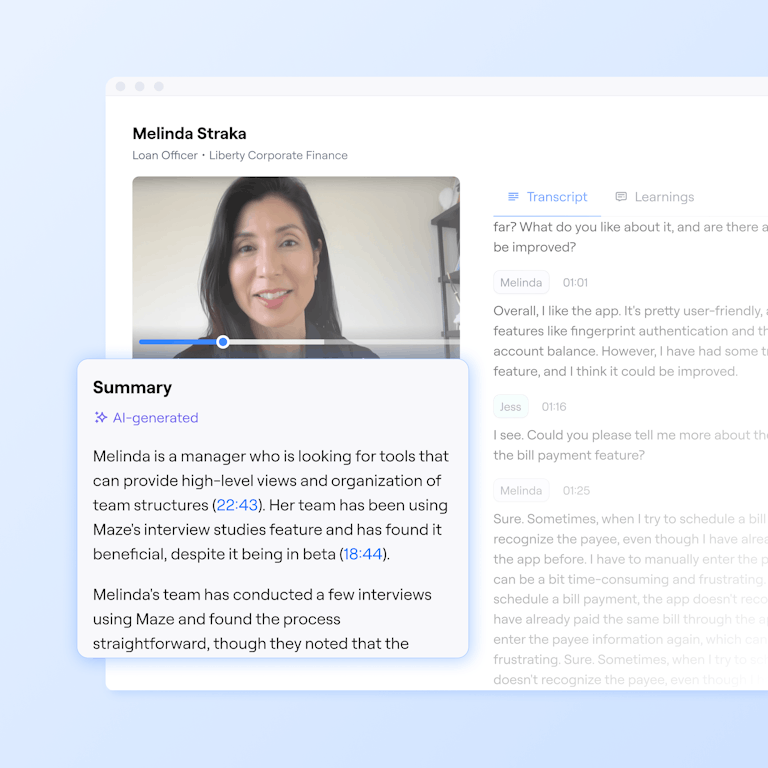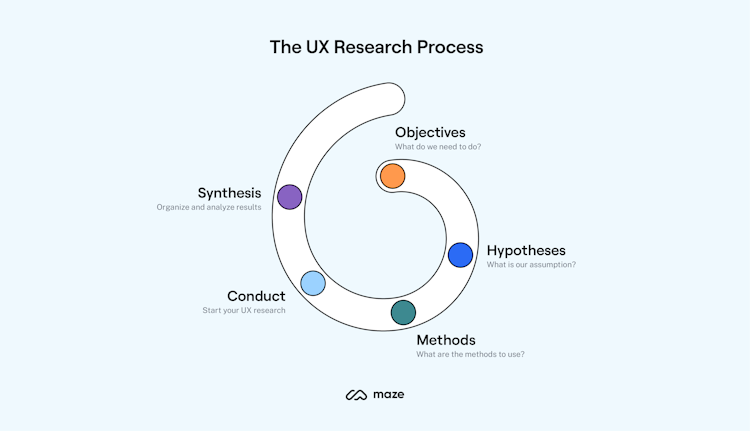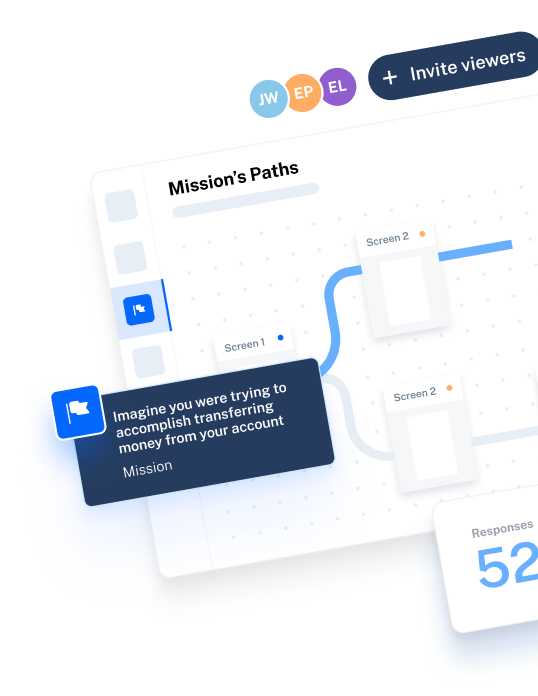Chapter 8
UX research process explained: 7 steps to better design (and common mistakes to avoid)
Here’s your step-by-step guide to implementing a user-centered UX research process that scales productivity and expedites time-to-insight.
Your platform’s user experience (UX) plays a major part in adoption and growth rates—but to maximize user-centricity and minimize wasted resources, you need a systematic approach to conducting UX research.
In this chapter we cover seven key steps to refine your UX research process and establish it within your organization. We’ll also explore the benefits of introducing a streamlined research process—and common mistakes to avoid, with top tips from industry pros.

Why you need a research process in UX design and development
If research allows you to gather insights to inform UX design and development decisions, having a tailor-made UX research process ultimately streamlines your research practices, and elevates the way you build products as a whole. Without a robust process in place, you can end up making decisions in the dark or conducting research only when your team has the spare capacity—which is likely a rare occasion.
“Skipping research causes you to miss out on opportunities to change directions or adjust your design to make the most impact. You should make sure you’ve taken the necessary steps to clarify and validate your direction,” warns Nick Simpson, Head of UX at Airteam.
A UX research process helps you make better use of your resources as you can anticipate potential design flaws and avoid redesigns. It’s also valuable in getting stakeholders involved early on and reinforcing the value of research throughout your organization.
7 Key steps in the UX research process
Each company’s UX research process is like a fingerprint: personal and distinctive. While there are similarities across the board, there is no one way to do UX research.
Individual UX research stages will vary, depending on the methods you use, your objectives, and the phase of the product development process you’re in. Here’s a broad list of steps to bear in mind when you conduct UX research:
1. Set research goals
The first step is to define your UX research objectives. These are the specific objectives you want to achieve from your study. They answer the question: What do we need to learn to improve the user experience? For example, you might want to understand why users abandon the checkout process, or figure out how intuitive your navigation is.
Here’s how you can set research goals:
- Start with the big questions. Think about what user problems or opportunities you’re trying to address. Are users struggling with a specific feature? Do you need feedback on a new prototype?
- Be specific and actionable. Broad goals like “improve the user experience” are too vague. Narrow it down to something like “identify pain points in the onboarding flow” or “compare user preferences for two product design options.”
- Align with business objectives. Good research doesn’t happen in isolation. Consider how your goals support larger company goals, like increasing conversions or reducing churn.
- Collaborate with stakeholders, your design team, and product managers early on. This step ensures everyone agrees on the research focus and understands how the findings will impact their decisions.
Tip ✨
While it’s good to have clear goals, don’t let them restrict your curiosity. Leave some room for discovery. Avoid leading questions or assumptions that can skew results.
2. Choose your research methods
Once your UX research objectives are clear, it’s time to decide how you’ll gather the insights you need. Start with the basics: qualitative vs. quantitative—the two categories that research methods generally fall into:
- Qualitative research focuses on understanding user needs, thoughts, feelings, and motivations. Methods like user interviews or open-ended surveys are great for this.
- Quantitative research deals with numbers and measurable research data. A/B testing, click tracking, or analytics can help answer questions like “How many users are dropping off at this step?”
Many UX research methods, like usability testing, can deliver both types of data depending on how you structure the tasks or track metrics.
Your methods can also vary based on specific needs:
- Evaluative or generative research: Evaluative methods, like usability testing, assess how well a design works. Generative methods, like focus groups or card sorting, inspire ideas for new solutions.
- Attitudinal or behavioral research: Attitudinal research captures what users say (e.g., UX surveys or interviews). Behavioral research observes what users do (e.g., diary studies or prototype testing).
- Moderated or unmoderated tests: Moderated tests involve live interaction, allowing follow-up questions and real-time observations. Unmoderated or remote usability testing, often conducted with tools like Maze, lets users complete tasks independently, minimizing bias and enabling scalability.
Pro tip 💡
Mix and match. Combining mixed methods research—like pairing user interviews (qualitative) with surveys (quantitative)—helps you cross-validate your findings and uncover both broad patterns and deeper insights.
3. Recruit your research participants
You’ve already determined what you want to learn (your goals) and how you’ll gather those insights (your methods). Now, it’s time to focus on who will provide the insights. If your participants don’t match your target audience, your research results may be skewed or outright misleading.
First, you need to define your ideal user. Start by clarifying who your product is for. Consider factors like:
- Demographics (e.g., age, location, occupation)
- Behaviors (e.g., app usage habits, buying frequency)
- Goals or pain points related to your product
Then, choose a recruitment method. Depending on your audience and resources, you can recruit through:
- Recruitment tools
- Your existing customer databases
- Social platforms like LinkedIn, Reddit, or niche forums
Use a screening questionnaire to filter out participants who don’t meet your requirements. For example, ask “How often do you use online shopping apps?” or “Have you switched mobile networks in the past year?” These questions help identify participants who align with your research objectives.
💡 With the Maze Panel you can easily recruit participants based on various demographic filters like industry, language, device, age, gender, and country. This way, you’ll uncover a broader range of user preferences, and gather a more comprehensive understanding of your target audience.
4. Plan your research session
This step ensures that your time with participants is productive, focused, and aligned with your UX research objectives. Here’s how:
- First, define the scope: What specific questions or tasks will you focus on? Make sure each element of your session ties directly to your research goals.
- For example, if you’re testing usability, prepare tasks that guide participants through key interactions.
- If you’re exploring user behavior, craft open-ended questions that encourage discovery.
- Choose your session format. Decide whether the session will be moderated or unmoderated, remote or in-person.
- Create a user testing script. Your script is your session’s blueprint, outlining the flow of tasks, questions, and prompts. A well-structured script ensures consistency and helps you collect comparable data across participants. Include:
- An introduction to set the tone and explain the session’s purpose
- Tasks or scenarios aligned with your goals
- Open-ended questions to uncover deeper insights
- Prepare the logistics. Test your tools and platforms to ensure everything runs smoothly. Arrange for note-taking or recording (with participants’ consent) to capture details for analysis later.
5. Conduct the research
A good rule of thumb? Research early and often to avoid wasting time on solutions nobody needs. Here are a few tips to help you conduct user research:
Start with clear instructions. No matter the method, participants need to know what’s expected of them. Begin each session or study with a brief overview of the purpose and tasks involved.
- Stick to your research objectives. Ensure your tasks or questions are directly tied to your research goals. If you’re running tree testing, for instance, focus on whether users can navigate to the correct category. In contrast, a diary study might focus on uncovering real-life use cases over time.
- Observe with intention. Pay attention to how participants interact with your designs or answer questions. For usability tests, watch for patterns like hesitation or unexpected clicks. For surveys, look for trends in responses that point to common frustrations or preferences.
- Minimize bias. Avoid influencing participants. In usability tests, this might mean staying quiet during tasks. In surveys, it’s about phrasing questions neutrally to avoid leading responses.
- Capture everything. Whether you’re recording usability sessions, collecting survey data, or analyzing card sorting results, ensure all data is saved and accessible for later analysis.
- Include AI in your research workflow: AI transforms UX research by automating data collection, spotting trends, and surfacing actionable insights faster than manual analysis.
Product tip 💡
Use Maze AI to transcribe videos in over 30 languages, summarize and highlight key learnings from video interviews, and automatically generate contextual follow-up questions in surveys.

6. Analyze your research findings
Once your testing sessions are complete, it’s time to turn your findings into actionable insights.
Depending on the type of research you’ve conducted, your user research analysis method will vary. For example:
- Thematic analysis for qualitative data: If you’ve conducted interviews or collected open-ended survey responses, identify recurring themes in user feedback. For example, if multiple users express frustration with navigation, group this feedback under a theme like “navigation issues.”
- Statistical analysis for quantitative data: For surveys, A/B testing, or analytics, analyze UX metrics like averages, success rates, or correlations. For example, if a new button design increases clicks by 30%, this is a clear sign it’s working.
- Path analysis for usability tests: If your research involves user flows or navigation paths, analyze how participants interacted with your product. Pinpoint where they struggled or deviated from expected paths to identify areas for improvement.
- Affinity diagramming for mixed methods: Combine insights from different sources into clusters to uncover relationships or trends. For example, link user complaints from interviews to specific usability metrics for a fuller picture.
Maze automatically generates a comprehensive report for each test, complete with key metrics like usability scores, mission analysis, and task success rates. You can highlight specific user quotes, tag themes, and add comments directly to the report. Once finalized, you can share your report via a secure link or download it as a PDF to present offline.
7. Share findings and implement insights
Start by preparing a clear and concise UX research report that highlights the key takeaways from your research. Use visuals like charts, heatmaps, or user paths to make data digestible, and include specific user quotes to add depth. Tailor your presentation to your audience: emphasize design recommendations for your design team, while focusing on business outcomes when speaking with stakeholders.
To make your research accessible long-term, store your findings in a centralized user research repository. Add metadata and tags to make searching easier and ensure your research remains valuable for future use. Regularly update and maintain this repository to keep it relevant.
Once findings are shared, it’s time to turn insights into actionable changes. Work closely with your design team and developers to implement the necessary updates. Ensure they fully understand the insights behind the changes to maintain alignment and avoid miscommunication. This collaboration transforms findings into practical, user-focused solutions.
Once updates are live, conduct follow-up tests and iterations to ensure the changes effectively resolve the issues. If your updated design still has usability gaps, refine your design process and test again. Continuous research through iterative cycles are the key to achieving a polished, user-centered experience.

Created by Erin Sanders, the Research Learning Spiral provides five main steps for conducting user research.
For more info on how to use specific research techniques, check out previous chapters to learn more about conducting different UX research methods and how to prepare individual UX research plans.
Mistakes to avoid in the UX research cycle
Conducting research and building out a UX research process comes with a lot of moving parts. This means there are many opportunities for product-shaping discoveries, but there are also many potential roadblocks or challenges you may face on the way.
Some common mistakes to look out for include:
- Not conducting research before launching a new feature or product: The worst UX research mistake you can make is not doing it at all. You’ll just end up making decisions based on assumptions rather than the user, which could set your products up to fail.
- Not testing a large sample or using a mix of methods: Product teams with limited resources or time may be tempted to reduce the pool of test participants or only conduct either quantitative or qualitative research (rather than a mix of both). With this approach, you risk getting biased results or misinterpreting your insights.
- Working in silos: If you don’t regularly share your insights with other teams, you could compromise all that hard work you did to get buy-in. You need co-operation from these important stakeholders to make the most of your research and get backing to make user-centric decisions.
- Wanting to please stakeholders at all costs: While stakeholder involvement is important, that doesn’t mean you should act on their every whim. Aligning your goals with the business strategy and clearly communicating those goals early will give you something to refer back to if a stakeholder request could derail your research goals.
Getting others to see the value behind research and building intentional ways of learning with a structured process across the organization makes UX research a highly beneficial company-wide practice. Partner up with an easy-to-use UX research platform like Maze to conduct continuous research, and use results to inform every design decision with user insights.
